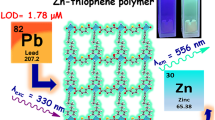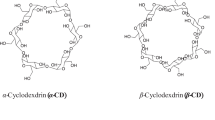Abstract
Two Co(II)-based coordination compounds, namely {[Co(apc)2]·H2O}n (1) and [Co(apc)2(H2O)2] (2), have been successfully prepared via reaction of a multifunctional ligand 2-aminopyrimidine-5-carboxylic acid (Hapc) with Co(NO3)2·6H2O based on different reaction environments. Both compounds were studied via elemental analysis (EA), single crystal X-ray diffraction analysis (SC-XRD), thermogravimetric analysis (TG), powder X-ray diffraction (PXRD) and infrared spectroscopy (IR). Fluorescence spectroscopy was employed to analyze the fluorescence properties of the ligand and the two compounds. The results revealed that the two compounds exhibited green and blue fluorescence, surpassing the original ligand in terms of properties. Based on the distinct fluorescence colors of the two compounds, there is potential to create multicolored fluorescent materials by adjusting their material ratios. This prospect could further extend their applications in the field of fluorescent materials.




Similar content being viewed by others
Data Availability
The data used to support the findings of this study are included within the article.
References
Zhang ZZ, Lee GH, Yang CI (2018) The use of a semi-flexible bipyrimidyl ligand for the construction of azide-based coordination polymers: structural diversities and magnetic properties. Dalt Trans 47:16709–16722
Zhao YM, Tang GM, Wang YT, Cui YZ, Ng SW (2018) Copper-based metal coordination complexes with voriconazole ligand: Syntheses, structures and antimicrobial properties. J Solid State Chem 259:19–27
Zhang JW, Hu MC, Li SN, Jiang YC, Qu P, Zhai QG (2018) Assembly of [Cu2(COO)4] and [M3(µ3-O)(COO)6] (M = sc, Fe, Ga, and in) building blocks into porous frameworks towards ultra-high C2H2/CO2 and C2H2/CH4 separation performance. Chem Commun 54:2012–2015
Xu Y, Ding F, Liu D, Yang PP, Zhu LL (2018) Syntheses, structures and properties of four cd(II) coordination polymers induced by the pH regulator. J Mol Struct 1155:72–77
Liu T, Zhang L, Tian Y (2018) Earthworm-like N,S-Doped Carbon Tube- Encapsulated Co9S8 nanocomposites derived from Nanoscaled Metal-Organic Frameworks for highly efficient Bifunctional Oxygen Catalysis. J Mater Chem A 6:5935–5943
Liu ZQ, Chen K, Zhao Y, Kang YS, Liu XH, Lu QY, Azam M, Al-Resayes SI, Sun WY (2018) Structural diversity and sensing Properties of Metal–Organic Frameworks with Multicarboxylate and 1H-Imidazol-4-yl-containing ligands. Cryst Growth Des 18:1136–1146
Zhang B, Zhang SH, Liu B, Yue KF, Hou L, Wang YY (2018) Stable Indium-Pyridylcarboxylate Framework: Selective Gas capture and sensing of Fe3+ ion in Water. Inorg Chem 57:15262–15269
Lei B, Wang M, Jiang Z, Qi W, Su R, He Z (2018) Constructing redox-responsive Metal–Organic Framework Nanocarriers for Anticancer Drug Delivery. ACS Appl Mater Interfaces 10:16698–16706
Jin H, Xu J, Zhang L, Ma B, Shi X, Fan Y, Wang L (2018) Multi-responsive luminescent sensor based on Zn (II) metal-organic framework for selective sensing of cr(III), cr(VI) ions and p-nitrotolune. J Solid State Chem 268:168–174
Fu HR, Wang KL, Zhao XX (2018) Crystal structure of poly[bis(1-methyl-[4,4′-bipyridin]-1-ium-κN)-tetrakis(µ3-sulfato-κ3O:O′:O′′)trizinc(II)], C22H22Zn3N4O16S4. Z Für Krist - New Cryst Struct 233:349–351
Fan W, Liu X, Wang X, Li Y, Xing C, Wang Y, Guo W, Zhang L, Sun D (2018) A fluorine-functionalized microporous In-MOF with high physicochemical stability for light hydrocarbon storage and separation. Inorg Chem Front 5:2445–2449
Sukanya P, Venkata Ramana Reddy C (2018) Synthesis, characterization and in vitro anticancer, DNA binding and cleavage studies of Mn (II), Co (II), ni (II) and Cu (II) complexes of Schiff base ligand 3-(2-(1-(1H-benzimidazol-2-yl)ethylidene)hydrazinyl)quinoxalin-2(1H)-one and crystal structure. App Organomet Chem 32:e4526
Tohidiyan Z, Sheikhshoaie I, Khaleghi M, Mague JT (2017) A novel copper (II) complex containing a tetradentate Schiff base: synthesis, spectroscopy, crystal structure, DFT study, biological activity and preparation of its nano-sized metal oxide. J Mol Struct 1134:706–714
Sun MY, Chen DM (2017) A rare high-connected metal-organic framework with an unusual topological net: synthesis, crystal structure and magnetic properties. Inorg Chem Commun 82:61–63
Duan H, Dan WY, Fang XD (2018) Zinc-coordinated MOFs complexes regulated by hydrogen bonds: synthesis, structure and luminescence study toward broadband white-light emission. J Solid State Chem 260:159–164
Llabrés I, Xamena FX, Casanova O, Galiasso Tailleur R, Garcia H, Corma A (2008) Metal organic frameworks (MOFs) as catalysts: a combination of Cu2+ and Co2+ MOFs as an efficient catalyst for tetralin oxidation. J Catal 255:220–227
Hamidipour L, Farzaneh F (2013) Cobalt metal organic framework as an efficient heterogeneous catalyst for the oxidation of alkanes and alkenes. React Kinet Mech Cat 109:67–75
Funding
The research was supported by Research on the Application of Inorganic Nanofunctional Composite Materials (XAWLKYTD202312), Natural Science Basic Research Plan in Shaanxi Province of China (2022JM-075) and Three-year action plan project of Xi’an University (21XJZZ0001-11).
Author information
Authors and Affiliations
Contributions
Jing Li and Liuchang Wang synthesized and characterized the compounds; Hongjiang Ren and Jiangtao Li performed other experiments.
Corresponding author
Ethics declarations
Ethical Approval
Research experiments conducted in this article with animals or humans were approved by the Ethical Committee and responsible authorities of our research organization(s) following all guidelines, regulations, legal, and ethical standards as required for humans or animals.
Competing Interests
The authors declare no competing interests.
Additional information
Publisher’s Note
Springer Nature remains neutral with regard to jurisdictional claims in published maps and institutional affiliations.
Rights and permissions
Springer Nature or its licensor (e.g. a society or other partner) holds exclusive rights to this article under a publishing agreement with the author(s) or other rightsholder(s); author self-archiving of the accepted manuscript version of this article is solely governed by the terms of such publishing agreement and applicable law.
About this article
Cite this article
Li, J., Ren, H., Li, J. et al. Potential Application Values of Two Multicoloured Coordination Compounds as Multicolor Luminescent Materials. J Fluoresc (2023). https://doi.org/10.1007/s10895-023-03450-6
Received:
Accepted:
Published:
DOI: https://doi.org/10.1007/s10895-023-03450-6




